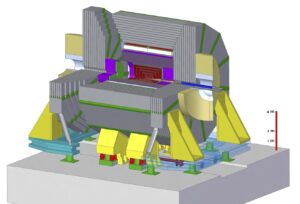Detectors for planned particle colliders don’t just appear. They are the product of a long process involving many specialists from many areas and institutes who propose, discuss, select and review the most optimised technologies for the complicated tasks they expect the detector to do. There are many milestones along the way, including the initial “letter of intent” that gathers those scientists willing to participate in the new project around a virtual table, the “detector baseline design” or “interim” and the final “technical design reports.” An interim report summarises the conclusions after several years of research and development of customised detector technologies, while the final technical design report stands at the end of this process, signaling the closing of R&D efforts in order to actually build the high-tech state-of-the-art apparatus. The two ILC detectors ILD and SiD have ticked off all milestones except the final one, and SiD has just published their thoughts on necessary changes from the baseline design – published in 2013 – to now.

“Discussions kicked off with this year’s Snowmass process where the American particle physics community sets the strategy for the next years,” explains SiD spokesperson Marcel Stanitzki from DESY. “We looked at the existing detector design from the hypothetical angle of a green light from Japan for the ILC. What would we change in SiD if it came now?” The existing design refers to the blueprint lined out in the SiD detector baseline design (DBD) that in turn relies on technology that was state-of the art then.
However, things move quickly in the detector developing world. New technologies have emerged that are often more efficient, more precise and even cheaper than those from five years ago. The standard chip feature size has also shrunk from 250 to 65 nanometers, making an overall design overhaul necessary anyway. “We might as well do that properly with the improved technologies,” concludes Stanitzki.
One such technology are monolithic active pixel sensors (MAPS), which have been around offering promising readout technology for a while, but have now offer more capabilites inside the pixels while giving a better yield. “The things you can integrate on MAPS chips these days are amazing,” Stanitzki says, “and there’s more to it than that: the sensors can even be made to bend into different shapes.” That means that in principle perfectly cylindrical detector layers are possible while before they had to be tiled into as much a barrel shape as possible. The system has been tried and tested for the future upgrade of the inner tracking system of the ALICE detector at the LHC.
MAPS would almost certainly move into SiD’s tracking system and electromagnetic calorimeter, replacing the silicon technology foreseen there in the DBD. Studies will need to determine the best pixel size for these systems, as well as whether SiD would go analogue or digital for their electromagnetic calorimeter.
With changes in the accelerator design and parameters, the interface between the detector and the accelerator also needs a brush-up, introducing updated systems like forward calorimeters or luminosity monitors and redesigning the hardware in that area – beam pipe, support tubes, piezo system and more.
The SiD team is also considering introducing new subsystems like timing layers, mostly to take advantage of recent improvements in fast-timing detectors. Timing layers add another dimension of information on the particle collision, making it easier to identify and track individual particles from a collision and resolve clusters of particles, following them through the individual detector layers.
“In short: we know the direction in which we’re heading, and while we certainly don’t want to kick out all the old tech we’re ready to let in the new tech that is ready,” concludes Stanitzki. Find out more about thoughts and future studies in their “SiD 2025” report.

Recent Comments